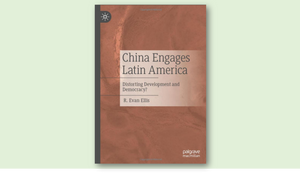
China’s Advance in Colombia in the Time of Gustavo Petro
From May 12 to May 16, 2025, the author was in Bogotá, Colombia, to deliver a presentation to the New Granada Military University and 300 senior military officers at Colombia’s National War College on activities by the People’s Republic of China (PRC) in the country and the region. The visit coincided with Colombian President Gustavo Petro’s trip to Beijing as part of the fourth leadership forum between the PRC and the Community of Latin American and Caribbean States (CELAC). The China-CELAC summit was a symbolic milestone in the PRC’s continuing advance in the region, as it seeks to leverage the region’s reaction to the new “America First” policies of the United States. At the summit, Petro, president pro tempore of CELAC, the PRC Belt and Road Initiative, sought to join the BRICS New Development Bank (NDB), engaged with the PRC on an offer to buy up to 24 J-10CE Chengdu Fighter aircraft, and visited the facilities of Huawei in Shenzhen, the favored contender to replace Western tech companies in providing a broad range of cloud, data, and telecommunication services for the Colombian government and commercial infrastructure. Less than a month earlier, the PRC donated 470 computers to the Colombian Foreign Ministry, creating risks of Chinese access to sensitive Colombian government data and communications.
Petro also signed 12 agreements during the trip, expressing interest in strengthening cooperation in investment, science, and a range of other areas. China has suggested, and Petro indicated his openness to, renewing Colombia’s previously abandoned initiative to negotiate a free trade agreement with the PRC, although with Colombia’s presidential elections less than a year away, and with the need for the Congress to ratify such an agreement, those consulted for this work universally regarded such aspirations as unrealistic.
China’s Restrained Commercial Advance in Colombia
China’s advance in Colombia is significant, spanning a broad spectrum of commercial, governmental, and other activities. That advance has more to do with deepening engagement by Chinese companies with Colombia’s private sector than the initiatives of President Petro. Indeed, the factor most limiting PRC engagement with Colombia in recent years has arguably been the environment of insecurity, economic malaise, and uncertainty expanded by Petro’s policies; the election of more conservative local politicians, partially as a response to those policies; and the failure of Petro’s proposals to China to contain concrete, realistic bases for working together. In the end, however, Petro’s increased boldness in embracing China could expand the PRC’s position in Colombia in ways disadvantageous to the country’s businesses, national autonomy, and the strategic interests of the United States and the region.
In commodities sectors, PRC-based companies continue to expand their commercial presence in Colombia, limited by criminal insecurity that has been deepened by Petro’s “total peace” and other policies. In May 2025, coinciding with the author’s visit, the Chinese company JHCX agreed to a $100 million project with Canadian mining company Cordoba Minerals to jointly develop the Alacrán mine in Córdoba. On the other hand, the Buriticá mine in Antioquia, acquired in 2019 from Continental Gold for almost $1 billion by the Chinese company Zijin, has been forced to halt its operations due to conflicts with illegal mining groups in the area, who are backed by the Gulf Clan. Zijin is suing the government for failing to provide adequate security to its mine.
In the petroleum sector, PRC-based companies are involved in three major operations: Omimex (with the Indian partner ONGC Videsh), Emerald Energy, and Nexxen, although the companies have largely withdrawn from Omimex. As in mining, however, the Chinese operations have been paralyzed by violence against their operations while also facing problems related to the inability of state partner Ecopetrol under its Petro-appointed administrator to conduct its own activities in the sector.
In infrastructure construction, China is moving toward completion of Phase 1 of the Bogotá metro in 2028—a project that has been almost 80 years in the making and for which a Chinese consortium won a contract in 2019. Chinese participation in Phase 2, due to be bid in July 2025, may be jeopardized by U.S. pressure on the International Monetary Fund not to finance any projects involving Chinese companies or lenders.
Virtually every other PRC infrastructure project is frozen. The Chinese-built Regiotram light rail from Bogotá to Zipaquirá has stalled over the inability of the Chinese builder to secure the legally required right of way from local communities, among other issues. The Chinese prospects to build the Medellín metro faded when the pro-Petro mayor of the city was defeated in October 2023 elections by conservative opponent “Fico” Gutiérrez. The election was part of a wave of defeats by Petro-aligned candidates in municipalities across the country.
As in Medellín, the possibility of PRC-based companies to participate in the “Cercanía” light rail project in Cali also decreased with the election of conservative Mayor Anthony Eder, who wants to contract the project to a trusted Western firm.
A Chinese consortium, China Airport Holdings, which participated in the management of the six airports in Eastern Antioquia, reportedly pulled out of the project after being marginalized by its Colombian partners in what it saw as unethical business dealings. When Bogotá expanded and modernized its El Dorado airport, two Chinese firms participated, but ultimately lost to the Opaín consortium. Nonetheless, Chinese firms are reportedly positioned to bid for the subsequent modernization of the national terminal from which Colombia’s military airline Satena flies, if the project eventually goes forward.
In the port sector, the military-affiliated Chinese logistics giant COSCO grabbed headlines by announcing a minor new service between its new megaport in Chancay, Peru, and the Colombian municipal port of Buenaventura. Still, Chinese companies do not actually operate the port, and its characteristics—such as a relatively shallow, silt-filled point of access—make its expansion into a major strategic pacific maritime hub unlikely.
In the agricultural sector, in contrast to the Southern Cone, where Chinese agrologistics firms Nidera and Noble, in partnership with COFCO, have been active, Colombian laws limiting large-scale land ownership have stalled progress.
In the power generation and transmission area, PRC-based firms have also had less success than elsewhere. The Chinese firm Sinohydro made an unsuccessful bid for the Hydroituango hydroelectric project in Antioquia. Later, in 2021, the company supported an ultimately unsuccessful bid by the Chinese “Yellow River” consortium, led by PowerChina, to displace the firms that had previously won the project. PowerChina has separately had some success working with other PRC-based companies in wind and solar projects in the country. It was reportedly a contender in a project proposed by Petro to develop wind-powered data centers in La Guajira in the northeast coast of Colombia, although technical experts note that the cooling demands of such facilities, combined with the high temperatures in the region, make such a project infeasible.
In transportation, the Chinese ride share company Didi Chuxing, which was once advancing rapidly in the Colombian market, is now most commonly used for food delivery.
In the automotive sector, Chinese car brands, represented by local distributors such as Cinascar and Motorysa, are also advancing in the Colombian market. BYD, whose electric vehicles were helped by their exemption from taxes and the “pico y placa” system that limit the days on which non-electric cars can be used, saw sales grow by 220 percent in 2024 alone. BYD is also the provider of 96 percent of all electric buses used in Colombia.
In finance, Chinese banks have not significantly entered the branch banking business in the country as they have in the Southern Cone and elsewhere.
In security systems, Chinese companies Hikvision and Dahua play a major role in the market for commercial and home security systems.
Beyond PRC presence in specific industries, the expansion of PRC-Colombia business ties is further reflected by the size of, and PRC participation in, the China-Colombia Chamber of Investment and Commerce. The chamber publicly lists 184 associates across 24 categories, up from approximately 30 associates little more than a decade ago. Ding Wen, whose company China Harbour plays the lead role in the previously mentioned Bogotá metro, is vice president of the organization. Huawei, Zijin, and Motorysa are also among its principal associates.
The Broader Advance of China-Colombia Relations
Beyond business, the PRC continues to strengthen its “people-to-people” networks in Colombia. The China-Colombia Friendship Association, led by Guillermo Puyana and composed of PRC-oriented Colombian scholars and political and economic elites, promotes ties with the PRC in the country. In addition, both houses of Colombia’s bicameral legislature have China caucuses, originally established in December 2023 following President Petro’s first trip to China, to implement the agenda for strengthening PRC ties that came out of that trip. Gloria Flórez, of President Petro’s Historic Pact movement, is a key member of the China caucus in the Colombian Senate. Colombian Senate head Iván Name Vásquez and House of Representatives leader Andrés Calle Agua were also both active in traveling to China and promoting greater legislative cooperation between the two countries until they were jailed on corruption charges in May 2025.
In the education domain, more than 200 Colombians are currently studying on scholarships in the PRC. Nonetheless, the number of Confucius Institutes for official PRC-sanctioned instruction in Chinese language and culture has not expanded beyond the three established a decade ago: the University of the Andes (Uniandes), Jorge Tadeo Lozano University in Bogotá, and an institute in Medellín that has actually ceased to affiliate itself with the prestigious private EAFIT University.
At the local level, multiple Colombian municipalities have established “sister city” and “sister province” relationships with the PRC. These include relationships between the Department of Antioquia (Colombia) and Fujian Province (China); Medellín (Colombia) and the province of Harbin and the cities of Beijing, Nanjing, Guangzhou, and Canton (China); Cali (Colombia) and Tianjin (China); Barranquilla and Nanjing (China); Ibagué (Colombia) and Chengdu (China); Nieva (Colombia) and Xi’an (China); Paipa (Colombia) and Pengzhou (China); and Armenia (Colombia) and Kunming (China). Such relationships create risks of improper influence, since oversight over paid trips to the PRC and other benefits conferred on local-level officials are not always as stringent as rules governing such activities at the national level.
Beyond people-to-people ties, the PRC is currently wooing the Colombian government to cooperate with the nascent Colombian Space Agency that it is building within its Air Force. It has already sought to bring space-focused Colombian Air Force officers to China for training.
In military affairs, the Chinese government has proceeded cautiously in Colombia. Although PRC Ambassador Zhu Jingyang is very active in Bogotá, the Chinese military attaché, Li Zhou, has been a much more elusive figure among Colombian military counterparts consulted for this work.
Although the previous Commanding General of the Colombian Armed Forces, Alberto Mejia, put an end to the practice of accepting gifts of Chinese military equipment, and although previous President Iván Duque ended the practice of hosting of Chinese military personnel in Colombian training programs like the Lanceros course, Colombian security experts consulted off the record noted that China has been exploring whether the Petro government is interested in resuming such interactions. In addition, Colombian military personnel continue to attend Chinese military schools such as the National Defense University in Changing and the Command and General Staff course near Nanjing. Colombia’s Nueva Granada military school sent 11 faculty and staff to China over the past two years, paid for by the PRC government, and has established a “Confucius Classroom” for PRC-sanctioned language instruction in the region.
Such activities, as well as Petro’s previously noted discussions with the PRC about purchasing 24 J-10 fighters, illustrate how quickly taboos against military cooperation with the PRC by Colombia, one of the closest U.S. security partners in the region, can change.
Risks of Future PRC Advances
Paradoxically, President Petro’s initiatives present the greatest risk in terms of expanding PRC engagement in Colombia in the strategically troublesome security, political, and technological domains, even while the uncertainty, insecurity, and economic malaise produced by his policies in other areas are a key limitation of productive Chinese engagement in the country. Sources close to Petro said the president was furious when he realized after the fact that the Belt and Road commitment he signed in Beijing was largely devoid of legal meaning.
Despite such self-inflicted limitations on PRC engagement, Colombia’s government could become more aggressive in its outreach to the PRC as President Petro becomes less concerned about the U.S. response and more focused on his legacy and desire to score symbolic points against Washington—particularly in the lead up to Colombia’s May 2026 national elections and following what he sees as an attempt by the United States to humiliate him over his visa denial.
The United States should not overplay the significance of Petro’s latest symbolic moves to embrace China, yet it should be vigilant about the risks created by Petro’s continuous improvisation in the face of a PRC patiently trolling for strategic opportunities.



